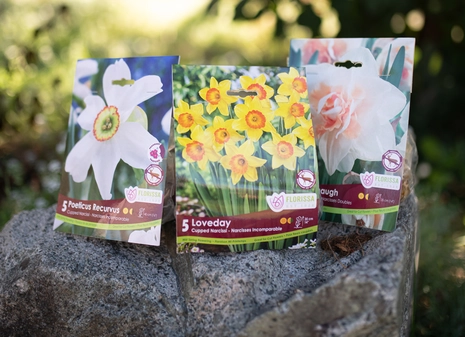Bulbs for Containers
Bulbs are great in containers, hidden by spring, summer and fall annuals you hardly know they’re there until suddenly they spring to life one April morning!
Choosing your Container
Good drainage is vital to bulbs, so choose pots with large holes. Terracotta pots are great for spring flowering bulbs because they are porous and allow water through their sides as well as their drainage holes. This lessens the chance of bulb rot during our wet, mild winters. Wooden containers also drain quite well.
Soil Mixes
A well-drained soil is essential for bulbs. Add either 10% crushed pumice rock or washed sand to our GARDENWORKS Planter Box Mix and you’re ready to go!
Fertilizing
When planting bulbs, be sure to fertilize with Bone Meal or specially formulated Bulb Fertilizer at planting and again just after blooming. Although both these fertilizers are similar, there is one major difference, being organic bone meal is slower to take effect. As a result, bone meal makes a better over-winter feed, while bulb food supplies a much-needed burst of nutrients in the spring.
Caring for your New Pot of Bulbs
Place your container outside in a sunny location where it gets natural rain or can be easily watered. Since most bulbs are more than hardy enough to stand our mild winters, there is no need to shelter them. You may apply a light mulch during heavy-frost periods, once the foliage and buds starts to show above the soil. Keep your container evenly moist, and avoid digging near the developing plants.
Moving the Pot
When in bloom, plant containers can be moved to the best site in the garden and if the pot is small enough can even be brought into the house. After blooming, the pot can be stored out of sight in a garage or shed, or carefully planted over with annuals for a spring, summer and fall show. During each re-planting be sure to be careful around the developing bulbs.
Potted Bulb Design Guide
Planting up your own recipe of colour is always fun! Almost all spring-flowering bulbs can be grown in pots. Try to choose bulbs that will flower at the same time, as this will create a bold colourful display.
Soft Colour Schemes
Pastel shades are probably the easiest way to create a soft look. A neat design trick is to break the pastels up with white or cream blooms somewhere in your container. This gives you a clean look and helps avoid it looking washed out. Another idea is doing a tone-on-tone colour combination, by choosing one colour but using two different shades with a neutral white or cream to soften it up. For example, use deep-purple, pale-purple and cream.
Bright Colour Schemes
For a burst of colour choose three consecutive colours on the colour wheel making sure you pick flowers with intense, saturated, rich colour.
Consecutive colours are:
- red, orange, yellow
- orange, yellow, green
- yellow, green, blue
- green, blue, purple
Or choose complementary colours. These are colours that are opposite on the colour wheel:
- purple and yellow
- orange and blue
- red and green
A Recipe for a 3-tiered Potted Design for Beginners
- The first tier of 5-7 tall yellow tulips forms the backbone of the planter planted right in the middle.
- The second tier of grape hyacinths (Muscari spp.) create a soft-looking ring planted around the centre planting of tulips and offer a colour contrast.
- The final and outer tier planting of yellow-centred primulas, will hug the edge of the pot, mirror the colour of tulips, and conveniently bloom at the same time as the rest of the pot.
For more information on planting bulbs be sure to check out the tip sheet on Naturalizing Bulbs.
Portions of this information sheet were extracted from “A Landscape of Bulbs,” by Heide Kim, originally published in GardenNotes, Issue #34, September 1996

